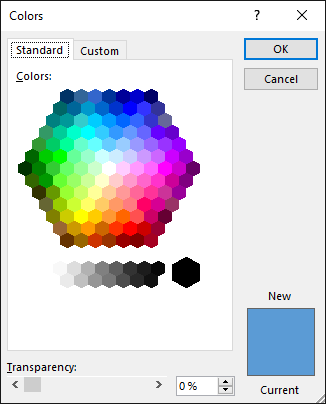Once you add gradient fills to shapes in PowerPoint 2016 for Windows, you may want to make the gradient fill look a little different, or even a whole lot different. Yes, you can use the More Gradients option to add different types of gradients as fills to the shapes but that only provides more gradient fill types, and does not let you customize the colors within the gradient.
Look at Figure 1, below, the rectangle on the top of this slide shows our original gradient that blends between just two colors, green and blue. The rectangle in between adds two more colors, a middle blue shade and a leafy green to end up with a 4 colored gradient. Finally, the rectangle at the bottom alters the transparency settings of some colors, you can thus see the slide background which in turn comprises 3 colors: white, grey, and black. In this tutorial, we'll step into a little more detail and show you how gradient stops work. When you are done with this tutorial, you can create your own gradients, or edit existing ones, as shown in Figure 1, below.

Figure 1: Add colors and transparency to your gradient stops
First let us explore what a Gradient Stop is. Quite simply, this is the point where a new color is introduced within the gradient blend. All gradients must have at least two or more stops, follow these steps to learn more:
- Select a shape, and access the Format Shape Task Pane as explained in the More Gradients tutorial. You'll end up with the pane that you can see in Figure 2. Note that all areas of this pane other than those that are concerned with Gradient Stops have been faded, an explanation of the options within the faded areas has already been provided in the More Gradients tutorial.

Figure 2: Gradient stops options - If you look at the first option in this area, you'll see that there is a gradient bar (highlighted in red within Figure 3) with 3 gradient stops.

Figure 3: Gradient bar - If you see less or more than the 3 stops, don't worry for now. As long as you have at least 2 stops, you should be fine. That's because a gradient needs at least two colors to exist. Figure 4 shows a shape filled with a simple 2 color gradient.

Figure 4: 2 Gradient stops - Look at Figure 4, it contains a gradient formed between dark blue and light green. You can see where the blue starts, and the green ends. These points, where a new color starts, ends, or just jumps in between is called a stop.
- Look at Figure 5 now, this one contains a gradient formed with 3 colors, the black in between the blue and green forms a stop at around the 35% mark (35% from the left).

Figure 5: 3 Gradient Stops - In PowerPoint 2016, you can add and remove gradient stops.
- To add a gradient stop, make sure that you have selected the existing gradient stop after which you want to insert a new stop. Then click the Add gradient stop button (highlighted in red within Figure 6). This will add a new stop exactly between the selected stop and the next stop. Otherwise, you can also simply click on the gradient bar on the position where you want to add a new stop.

Figure 6: Add Gradient Stop button - To remove a gradient stop, just select the stop you want to remove, and then click the Remove Gradient Stop button (highlighted in red within Figure 7). You can also drag the gradient stop off the gradient bar to remove it.

Figure 7: Remove Gradient Stop button - After you have added gradient stops, you can change their position. To do that just click on the stop that you want to change the position of and drag it along the gradient bar to the new position. These stop positions are calculated percentage-wise from 0 to 100%.
- If you want to move a stop to a precise position, first select the stop you want to change the position of, and enter a percentage value in the Position box, as shown highlighted in red within Figure 8.

Figure 8: Change the position of your gradient stop - You can also change the color of a stop. First select the stop for which you want to change the color, and then click the Color button (highlighted in red within Figure 9). This will bring up the Color drop-down gallery, see Figure 9 again.

Figure 9: Color drop-down gallery - The options within the Color drop down gallery are explained below, you'll need to choose any one of these options for the stop color:
A. Theme Colors
- Here you can select any of the colors which are from the active Theme of the presentation. You can also select any of the 5 tints or shades for any Theme color. Learn more about Themes here.
B. Standard Colors
- Here you can choose from any of the ten standard colors, these ten standard colors are just choices of colors that PowerPoint believes to be widely used. You don't have to limit yourself to either the Theme colors or Standard colors, as you'll learn in the next options, although it's a good design idea to use Theme colors as far as possible.
C. Recent Colors
- Here you can find the colors most recently used. If you have just launched PowerPoint and created a new presentation, the Recent Colors option may be entirely absent since you haven't selected any color recently!
D. More Colors
- This option is to summon the Colors dialog box as shown in Figure 10. This dialog box has two tabs: Standard and Custom, first select the Standard tab (again, refer to Figure 10).

Figure 10: Standard tab within the Colors dialog box - The Standard tab offers 127 colors in a honeycomb style palette, 14 gray shades, black and white. You can even change the transparency value of the selected color in the Transparency slider below. If you want more color choices, then select the Custom tab of the same dialog box, as shown in Figure 11.

Figure 11: Custom tab within the Colors dialog box - Within the Custom tab, you can chose any color from the spectrum and later adjust the selected color's luminosity with the slider on the right. You can even enter specific values of RGB and HSL to create a specific color, all these combinations provide 16 million color choices!
- Again, you can even change the transparency value of the selected color in the Transparency slider below.
- Choose any color and click OK to apply it.
E. Eyedropper
- This is the new option in PowerPoint 2016, the Eyedropper option enables you to pick an exact color from anywhere, even from somewhere outside PowerPoint.
- You can also change the Transparency level of each stop color, first select the stop and then use the Transparency slider or enter the transparency value percentage-wise (both the slider and the box are shown highlighted in red within Figure 12, below).

Figure 12:Change transparency values - 0% transparency equates to no transparency, and full opacity. 100% transparency equates to full transparency, and no opacity.
- Use the Brightness slider (highlighted in blue within Figure 12, above) to change the brightness level of the stop color. Moving the slider towards left makes the color darker and moving it towards right makes the color brighter. You also have an option of directly entering the brightness value from 0% to 100% in the box next to the Brightness slider.
- Select the Rotate with shape check-box (highlighted in green within Figure 12, above) to rotate the gradient fill when its container shape is rotated.
- Save your presentation often.















